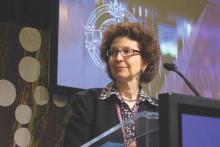WASHINGTON – A 6% allantoin cream has shown good results in healing wounds caused by epidermolysis bullosa (EB), with 82% of patients getting a complete closure by 2 months, in a phase IIb study.
The results of the 3 month study were good enough to propel that dose into both an open label and a phase III study, Dr. Amy Paller said at the annual meeting of the American Academy of Dermatology.
SD-101 (Zorblisa) may not be a “game-changer” in terms of disease modification, but it’s an enormous step forward in symptomatic treatment, Dr. Paller said in an interview. The active ingredient, allantoin – used for years at low concentrations in cosmetics and emollients – imparts virtually no adverse effects, and may, at this higher dosage, actually be working on a cellular level, she added.
Although its mechanism has not been fully elucidated, allantoin seems to help reduce inflammation, loosen protein bonds, and promote collagen formation. It also has some bactericidal effects, she noted.
“We see that healing is improved and inflammation is decreased. Many patients also report less itching and pain, which can speed dressing changes, and that is a huge quality of life issue for families. Although these results are still early stage, and in a small number of patients, they were enough for us to move forward,” said Dr. Paller, professor and chair of the department of dermatology and professor of pediatrics at Northwestern University, Chicago.
At the meeting, she discussed the phase IIb study, which compared allantoin 6%, allantoin 3%, and a vehicle cream, in 48 patients aged 6 months to 44 years old. Most had the recessive dystrophic form of EB, which is associated with skin and mucosal blistering; orofacial and esophageal narrowing; anemia; and growth restriction. Older patients have a high risk of aggressive skin cancers.
The less severe EB simplex form was present in 11 patients; 8 had the most severe junctional form. The median size of the target lesion was about 8 cm2; the largest was 39 cm2. The baseline body surface area of lesional skin was 19%, with the largest area encompassing 48%. The target wounds were a median of 182 days in age, although this varied widely, from 21 to 1,600 days.
The cream was applied to the target lesion once a day. The study’s primary endpoint was target wound healing at 1 month; secondary endpoints included time to wound closure and the change in total body surface area of lesional skin. Assessments were conducted at baseline and at 14, 30, 60, and 90 days.
In the evaluable population of 45 patients, the 6% cream was most successful in effecting complete target wound closure at 1 month: 67%, compared with 38% for allantoin 3% and 41% for the vehicle (P = .165 for allantoin 6% vs. placebo).
And at 2 months, complete closure of the target wound occurred in 82% of the high dose group, compared with 44% of the low dose group and 41% of the vehicle group (P = .04 for allantoin 6% vs. placebo).
Results were similar at 3 months (82% for the high dose group, vs. 56% and 53% for the 3% and vehicle groups, respectively); this difference was not statistically significant (P = .124 for allantoin 6% vs. placebo).
These results equated to a significantly faster time to total wound closure in the allantoin 6% group (a median of 30 days vs. 86 days in the low dose group and 91 days for placebo).
Treatment emergent adverse events were low and were similar between the groups. Itching occurred in 13% of those in each active group and in 6% of those in the placebo group. Fever was most common in the high dose group (33% vs. 19% of the low dose group, and 12% of the placebo group.) However, those in the placebo group experienced more rash, erythematous rash, and oropharyngeal pain.
There were no deaths or severe adverse events in any group, according to Dr. Paller.
The study has evolved into an open label extension study that includes 42 patients in the original cohort. To date, 28 patients have completed 12 months of treatment. The time line shows a steady decrease in the body surface area of lesional skin, with a mean 3.4% decline from baseline to 1 year, she noted. Patient baselines were reset at 0, so these improvements were measured on top of any that may have occurred during the IIb study, she pointed out.


